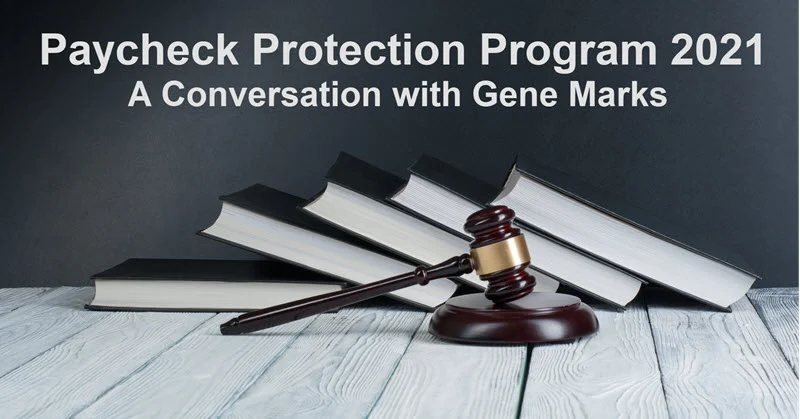Joining us today is Gene Marks from the Marks Group PC. He is an author, a speaker on small business expertise, and a CPA. He has presented at Scaling New Heights. He was one of our guests on the Round Tables back in March for the CARES Act when we were trying to figure out what was happening with coronavirus relief. He writes regularly for The Hill, the Philadelphia Inquirer, Forbes, Entrepreneur Magazine, and The Guardian, and appears regularly on MSNBC, CNBC, Fox Business and Fox News. He’s the author of six books on business management and comes to us today compliments of our friends at Patriot Software, a leading payroll provider which works with QuickBooks Integrated Payroll.
Joe Woodard: Thanks, Patriot. Gene, I'm going to start out with an open-ended question. What qualifies a person to receive this round of PPP (Paycheck Protection Program)?
Gene Marks: Joe, thanks for having me on. Your question about what qualifies somebody to get PPP in this round is obviously the biggest question that's being asked. So let's dig into some of the details.
If you didn't get a PPP loan in the first two rounds (this is the third round of PPP), you can certainly get it now. You can apply for it. So that's all well and good. If you want a second round loan, you can apply for that as well. But the limitations have been significantly increased. For another round of PPP, you must spend all the money from your first round of PPP. You must have less than 300 employees at a physical location. Some people have asked me, what if we have five physical locations and 300 employees at each of those locations? And unfortunately, the wording is a little unclear about that. The way that I read it is that before, any company with a total of 500 employees or less could qualify. Now employers with 300 employees or less can qualify.
For this round, you must show that your revenue is 25% less than before. Now what do I mean by before? It is based on your revenue and either the first, second, or third quarter of 2020. Any one of those quarters can apply for this condition to be satisfied. It does not have to be all three. And it must be compared to the same quarter in 2019. If your revenues fell by 25% in the first, second, or third quarter in 2020, compared to the same quarter in 2019, you would be eligible for this round. If you weren’t in business during the first three quarters of 2019 but were in business during the fourth quarter of 2019, you can compare that quarter to the first, second or third quarter of 2020.
Some companies are not eligible for this round of PPP. Those include businesses with start dates subsequent to February 15, 2020, publicly held companies and entities that are more than 50% owned by anyone in the People’s Republic of China. However, nonprofits, housing co-ops, news organizations, veterans organizations, tribal businesses, self-employed individuals and independent contractors are all eligible for this round of PPP – even if they filed for bankruptcy!
PPP loan criteria remain the same. If a borrower does not apply for loan forgiveness, payments are deferred 10 months after the end of the covered period for the borrower’s loan forgiveness (either 8 weeks or 24 weeks). Owners' compensation is limited to $100,000 for each owner, partner or S corporation shareholder over that period. Average monthly payroll costs should be multiplied by 2.5.
The only thing that has changed is that if you are in certain industries you can receive a loan up to 3.5 times your average monthly payroll costs. Eligible industries for the higher loans include restaurants, food services, travel businesses, RV parks, and other businesses with industry codes beginning with 72.
Revenues should be determined based on the basis used to compute taxes. If you file on the cash basis, you use cash basis-determined revenues for purposes of PPP loan amount computations. If you file on the accrual basis or a hybrid basis, then you use that basis to determine your revenues.
Joe Woodard: I heard you say that you must spend the PPP proceeds from a previous round before you get the next round of PPP. How do they measure that you spent it? Is it based on the Form 941 you filed for the fourth quarter, or on your application for forgiveness?
Gene Marks: That's a good question that you are going to have to take up with your lender. The theory is that if you have received a PPP loan previously and spent all the proceeds to cover all of your applicable forgivable expenses, then 60% has to be spent on payroll and 40% on non-payroll expenses. If you can justify that that money has been spent essentially on forgivable expenses, then you would then be eligible to apply for a second round.
Joe Woodard: Okay, so we just don't know if that's how it’s going to be when you have to apply for forgiveness. My hope would be that this is the case. And I think the only realistic thing to do to get the money flowing is to base it off your quarterly payroll filings. What they can't tell, though, is that the other 40% was spent on forgivable expenses.
Gene Marks: You would have to justify these expenses as if you’re applying for forgiveness.
Joe Woodard: If I had a magic wand, my lender would say that if you had payroll costs that covered 100% of the forgivable amount then you’re good. If you must supplement that with non-payroll costs, that's available information. But if it's something I have to fill out a form for, I may have to apply for forgiveness. There were lots of balloons that hadn’t quite landed the last time we did this. So we are used to this.
Gene Marks: Yes, the conversation that we are having right now is still going on in this period. The SBA has been given 10 days to come up with final rules about some of these things. And there is no way that it is going to meet that 10-day requirement. There's going to be more clarification to come.
.png?width=150&height=63&name=TWRlogo-regmark_blueblack%20(1).png)
.png)










Do you have questions about this article? Email us and let us know > info@woodard.com
Comments: